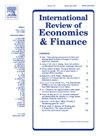开放经济中CBDC负利率政策的宏观经济效应:数量和价格规则的比较
IF 5.6
2区 经济学
Q1 BUSINESS, FINANCE
引用次数: 0
摘要
我们构建了一个小型开放经济的动态随机一般均衡(DSGE)模型,以研究央行数字货币(CBDC)负利率对宏观经济各个部门的影响。此外,我们分析了基于数量和价格的货币政策的异质反应。我们的研究结果可以总结如下。(1)在开放经济条件下,CBDC负利率政策可以打破存款利率零利率下限约束,增强央行在经济衰退时期的宏观调控能力。这为防止“流动性陷阱”提供了一种新的货币政策工具。(2) CBDC负利率可以强化数量型和价格型货币政策的有效性。具体而言,它既放大了数量型货币政策的短期效应和价格型货币政策的中长期效应,又延长了数量型货币政策的有效持续时间,缩小了价格型货币政策的传导时滞。(3) CBDC负利率可以加强长短期货币政策工具之间的联动,提高宏观经济部门对外部货币政策冲击的敏感性,增强货币政策传导机制的顺畅运行。本文章由计算机程序翻译,如有差异,请以英文原文为准。
Macroeconomic effects of CBDC negative interest policy in an open economy: A comparison of quantity and price rules
We construct a Dynamic Stochastic General Equilibrium (DSGE) model of a small open economy to investigate the effects of central bank digital currency (CBDC) negative interest rates on various sectors of the macroeconomy. Furthermore, we analyze the heterogeneous responses of quantity-based and price-based monetary policies. Our findings can be summarized as follows. (1) In an open economy, the CBDC negative interest rate policy can enhance the central bank's macroeconomic regulatory capacity during recessions by breaking the zero lower bound constraint on deposit interest rates. This provides a novel monetary policy tool to prevent "liquidity trap". (2) CBDC negative interest rates can strengthen the effectiveness of the quantity-based and price-based monetary policies. Specifically, it not only amplifies the short-term effects of quantity-based monetary policy and the medium- and long-term effects of price-based monetary policy, but also prolongs the effective duration of quantity-based monetary policy and reduces the transmission time lag of price-based monetary policy. (3) CBDC negative interest rates can strengthen the linkage between long-term and short-term monetary policy tools, increase the sensitivity of macroeconomic sectors to foreign monetary policy shocks, and enhance the smooth functioning of the monetary policy transmission mechanism.
求助全文
通过发布文献求助,成功后即可免费获取论文全文。
去求助
来源期刊
CiteScore
7.30
自引率
2.20%
发文量
253
期刊介绍:
The International Review of Economics & Finance (IREF) is a scholarly journal devoted to the publication of high quality theoretical and empirical articles in all areas of international economics, macroeconomics and financial economics. Contributions that facilitate the communications between the real and the financial sectors of the economy are of particular interest.

 求助内容:
求助内容: 应助结果提醒方式:
应助结果提醒方式:


